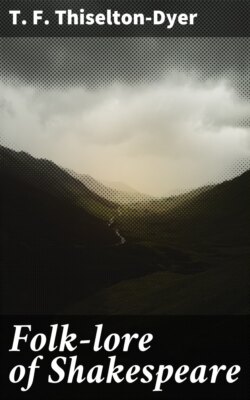Читать книгу Folk-lore of Shakespeare - T. F. Thiselton-Dyer - Страница 26
На сайте Литреса книга снята с продажи.
Footnote
ОглавлениеTable of Contents
[89] Singer’s “Shakespeare,” vol. x. p. 292.
[90] “Illustrations of Shakespeare,” 1839, pp. 255, 256.
[91] Singer’s “Shakespeare,” vol. viii. p. 208.
[92] See Knight’s “Life of Shakespeare,” 1843, p. 63.
[93] “Pop. Antiq.,” 1849, vol. iii. p. 241.
[94] See Swainson’s “Weather-Lore,” 1873, p. 176, for popular adages on the Continent.
[95] “Weather-Lore,” pp. 175, 176.
[96] Napier’s “Folk-Lore of West of Scotland,” 1879, p. 141.
[97] Quoted in Southey’s “Commonplace Book,” 1849, 2d series, p. 462.
[98] See Tylor’s “Primitive Culture,” 1871, vol. i. pp. 261, 296, 297, 321.
[99] In “3 Henry VI.” (ii. 1), Edward says:
“henceforward will I bear
Upon my target three fair shining suns.”
[100] “Glossary to Shakespeare,” p. 283.
[101] Ray gives the Latin equivalent “Ab equis ad asinos.”
[102] Baring-Gould’s “Curious Myths of the Middle Ages,” 1877, p. 190.
[103] Cf. “Love’s Labour’s Lost” (v. 2): “Yet still she is the moon, and I the man.”
[104] Fiske, “Myths and Mythmakers,” 1873, p. 27.
[105] “Curious Myths of the Middle Ages,” 1877, p. 197.
[106] Douce’s “Illustrations of Shakespeare,” 1839, p. 10.
[107] For further information on this subject, see Tylor’s “Primitive Culture,” 1873, vol. i. pp. 288, 354-356; vol. ii. pp. 70, 202, 203.
[108] See Brand’s “Pop. Antiq.,” vol. iii. pp. 142, 143.
[109] See “English Folk-lore,” pp. 43, 44.
[110] “Primitive Culture,” 1873, vol. i. pp. 354, 355.
[111] The words “moonish” (“As You Like It,” iii. 2) and “moonlike” (“Love’s Labour’s Lost,” iv. 3) are used in the sense of inconstant.
[112] See Douce’s “Illustrations of Shakespeare,” 1839, p. 18.
[113] Tylor’s “Primitive Culture,” vol. i. p. 329.
[114] “Illustrations of Shakespeare,” 1839, p. 16.
[115] See Scot’s “Discovery of Witchcraft,” 1584, pp. 174, 226, 227, 250.
[116] For further examples, see Douce’s “Illustrations of Shakespeare,” p. 17.
[117] See Douce’s “Illustrations of Shakespeare,” 1839, p. 116.
[118] See Swainson’s “Weather-Lore,” 1873, pp. 182-192.
[119] See Tylor’s “Primitive Culture,” 1873, vol. i. p. 130; “English Folk-Lore,” 1878, pp. 41, 42.
[120] See Swainson’s “Weather-Lore,” pp. 182, 183.
[121] See Williams’s “Superstitions of Witchcraft,” pp. 123-125; Scot’s “Discovery of Witchcraft,” bk. iv. p. 145.
[122] “Illustrations of Shakespeare,” 1839, p. 405.
[123] Nares’s “Glossary,” 1872, vol. ii. p. 580.
[124] “Primitive Culture,” vol. i. p. 131.
[125] Cf. “Richard III.” (iv. 4); “1 Henry IV.” (i. 1, iii. 1); “Antony and Cleopatra” (iii. 13); “The Tempest” (i. 2); “Hamlet” (i. 4); “Cymbeline” (v. 4); “Winter’s Tale” (iii. 2); “Richard II.” (iv. 1).
[126] “Primitive Culture,” vol. i. p. 131; see Brand’s “Popular Antiquities,” 1849, vol. iii. pp. 341-348.
[127] “Walton’s Lives,” 1796, p. 113, note.
[128] Douce’s “Illustrations of Shakespeare,” 1839, p. 397.
[129] Ibid. p. 3.
[130] See Brand’s “Pop. Antiq.,” 1849, vol. iii. p. 400.
[131] Purchas, “His Pilgrimes” (1625, pt. i. lib. iii. p. 133), quoted by Mr. Aldis Wright in his “Notes to The Tempest,” 1875, p. 86.
[132] See Puck as Will-o’-the-Wisp; chapter on “Fairy-Lore.”
[133] See “Notes and Queries,” 5th series, vol. x. p. 499; Brand’s “Pop. Antiq.,” 1849, vol. iii. p. 410; Nares’s “Glossary,” vol. i. p. 309.
[134] A “fire-drake” appears to have been also an artificial firework, perhaps what is now called a serpent. Thus, in Middleton’s “Your Five Gallants” (1607):
“But, like fire-drakes,
Mounted a little, gave a crack and fell.”
[135] “New Illustrations of the Life, Studies, and Writings of Shakespeare,” vol. ii. p. 272.
[136] See Thoms’s “Notelets on Shakespeare,” p. 59.
[137] “Fairy Mythology,” edited by Hazlitt, 1875, p. 40.
[138] Among the many other names given to this appearance may be mentioned the following: “Will-a-wisp,” “Joan-in-the-wad,” “Jacket-a-wad,” “Peg-a-lantern,” “Elf-fire,” etc. A correspondent of “Notes and Queries” (5th series, vol. x. p. 499) says: “The wandering meteor of the moss or fell appears to have been personified as Jack, Gill, Joan, Will, or Robin, indifferently, according as the supposed spirit of the lamp seemed to the particular rustic mind to be a male or female apparition.” In Worcestershire it is called “Hob-and-his-lanthorn,” and “Hobany’s” or “Hobnedy’s Lanthorn.”
[139] Mr. Ritson says that Milton “is frequently content to pilfer a happy expression from Shakespeare—on this occasion, ‘night-wanderer.’” He elsewhere calls it “the friar’s lantern.”
[140] Thorpe, “Northern Mythology,” 1852, vol. iii. pp. 85, 158, 220.
[141] “Notelets on Shakespeare,” pp. 64, 65.
[142] Ibid.
[143] See Proctor’s “Myths of Astronomy;” Chambers’s “Domestic Annals of Scotland,” 1858, vol. ii. pp. 410-412; Douce’s “Illustrations of Shakespeare,” pp. 364, 365.
[144] See Patterson’s “Insects Mentioned by Shakespeare,” 1841, p. 145.
[145] “Letters,” vol. i. p. 310; vol. vi. pp. 1, 187.—Ed. Cunningham.
[146] Douce’s “Illustrations of Shakespeare,” 1839, p. 369.
[147] See Tylor’s “Primitive Culture,” vol. i. pp. 364-367.
[148] See Swainson’s “Weather-Lore.”
[149] Batman upon Bartholomæus—“De Proprietatibus Rerum,” lib. xi. c. 3.
[150] Polwhele’s “Cornish Vocabulary.”
[151] Cf. “Macbeth,” iii. 4, “O, these flaws and starts.”
